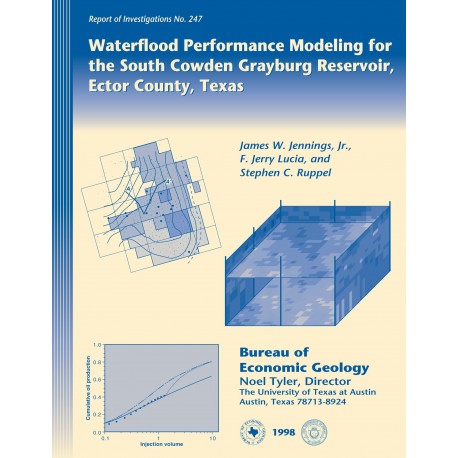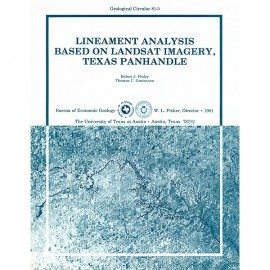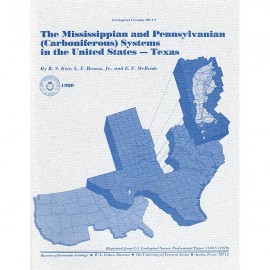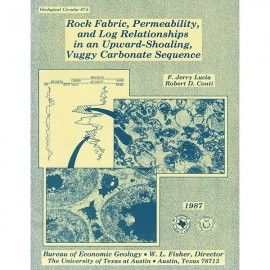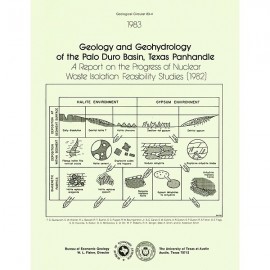Reports of Investigations
-
Books & Reports
- Reports of Investigations
- Guidebooks
- Udden Series
- Geological Circulars
- Down To Earth
- Atlases of Major Oil and Gas Reservoirs
- Texas Memorial Museum Publications
- Environmental Geologic Atlas of the Texas Coastal Zone
- Mineral Resource Circulars
- Other Reports
- Seminars and Workshops
- Handbooks
- Submerged Lands of Texas
- Symposia
- Annual Reports
- Open File Reports
-
Maps & Cross Sections
- Thematic Maps
- Miscellaneous Maps, Charts & Sections
- Geologic Atlas of Texas
- STATEMAP Project Maps
- Geologic Quadrangle Maps
- Cross Sections
- Highway Geology Map
- Energy and Mineral Resource Maps
- Shoreline Change and Other Posters
- Wilcox Group, East Texas, Geological / Hydrological Folios
- Bouguer Gravity Atlas of Texas
- River Basin Regional Studies
- Featured Maps
- Posters
- Teachers & the Public
-
Geological Society Publications
- Gulf Coast Association of Geological Societies
- Alabama Geological Society
- Austin Geological Society
- Corpus Christi Geological Society
- Houston Geological Society
- Lafayette Geological Society
- Mississippi Geological Society
- New Orleans Geological Society
- South Texas Geological Society
- GCS SEPM Publications
- Historic BEG & UT Series
Waterflood Performance Modeling for the South Cowden Grayburg Reservoir, Ector County, Texas
RI0247
For a downloadable, digital version: RI0247D.
RI0247. Waterflood Performance Modeling for the South Cowden Grayburg Reservoir, Ector County, Texas, by J. W. Jennings, F. J. Lucia, and S. C. Ruppel. 46 p., 37 figs., 4 tables, 1998. Print.
To purchase this publication as a downloadable PDF, please order RI0247D.
About This Publication
This Report of Investigations describes a geological, petrophysical, and reservoir engineering study of the South Cowden field, Ector County, in West Texas.
ABSTRACT
A geological, petrophysical, and reservoir engineering study was conducted of waterflood performance in the South Cowden field, an Upper Permian Grayburg reservoir on the Central Basin Platform in West Texas. The study was undertaken to understand the historically poor waterflood performance, obtain insight on the location of remaining mobile oil, determine the parameters having the most influence on waterflood performance predictions, evaluate three techniques for incorporating petrophysical measurements and geological interpretation into heterogeneous reservoir models, and identify issues in fluid-flow scaleup and heterogeneity modeling that require further research. The approach included geological description of the field stratigraphy and diagenesis, petrophysical modeling, analysis of relative permeability data, analysis of injection and production data, heterogeneity modeling, and waterflood simulation.
Partial completions, vertical permeability, and relative permeability were the most important parameters affecting waterflood performance predictions. The results were also influenced by the heterogeneity modeling procedure.
The poor waterflood recovery at South Cowden is due, in part, to completion of production and injection wells in only the top half of the formation; some of the remaining mobile oil is located in the poorly swept bottom half of the reservoir. Recompletion of wells through the entire formation is estimated to improve recovery in 10 yr by 6 percent of the original oil in place in some areas of the field.
All the flow simulations required a vertical-to-horizontal permeability ratio (kv l kh) smaller than that measured in whole core to explain waterflood behavior, suggesting the presence of barriers to vertical flow not explicitly accounted for in any of the heterogeneity models. The flow simulations also required modifications to the measured steady-state relative permeabilities, suggesting that small-scale heterogeneities and scaleup are significant. Vertical flow barriers, small-scale heterogeneity modeling, and relative permeability scaleup require additional research for waterflood performance prediction in reservoirs like South Cowden.
One of the heterogeneity models used in the study was based upon stochastic three-dimensional sequential-Gaussian simulations conditioned to well-log data. This model produced the best fit to waterflood performance and injectivity, but a simpler model based on two-dimensional smooth mapping of vertically averaged properties within each high-frequency cycle was almost as good. The results reaffirm the importance of large-scale heterogeneities in waterflood modeling but demonstrate only a slight advantage for stochastic modeling at this scale.
Keywords: Ector County, Grayburg Formation, heterogeneity modeling, scaleup, South Cowden field, Texas, waterflood performance prediction
CONTENTS
Abstract
Introduction
Geologic Framework and Diagenesis
Geologic framework
Diagenesis
Petrophysical Modeling
Porosity
Initial water saturation
Permeability
Relative Permeability Modeling
Relative permeability measurements and models
Choosing kr models for flow simulation
Initial-residual oil saturation models
Production and Injection History
Pressure history and fluid properties
Injection and production balance
Waterflood displacement performance
Displacement of initially mobile water
Injectivity, injection patterns, and well completions
Heterogeneity Modeling
Smooth interpolation of HFC averages
Stochastic simulation of HFC averages
Three-dimensional stochastic simulation
Constant-HFC and uniform models
Waterflood Simulations
Model parameters
Waterflood displacement results
lnjectivity predictions
Remaining Mobile Oil
Conclusions and Recommendations
Acknowledgments
References
Figures
1. Shallow-water carbonate platform reservoirs of West Texas and New Mexico, including those producing from the Grayburg Formation
2. Unit boundaries and structure on top of the Grayburg Formation in the South Cowden field
3. Stratigraphic cross section A-A' illustrating high-frequency sequences and cycles in the South Cowden field
4. Map of the South Cowden field showing the location of altered dolomite intervals
5. Map of the South Cowden field showing the location of altered and removed anhydrite
6. Map of anhydrite alteration and dissolution based on cross plots of sonic travel time and neutron-density porosity
7. Steady-state and unsteady-state kr measurements with increasing water saturation
8. Steady-state and unsteady-state kr models with increasing water saturation
9. Initial-residual oil saturation models used to set residual oil saturations for kr endpoint scaling
10. Cumulative total fluid production and water injection volumes corrected to subsurface conditions for the South Cowden field, 1965-1993
11. Cumulative total fluid production and water injection corrected to subsurface conditions for sections 5-8, 1965-1993
12. Waterflood displacement performance for sections 5-8 compared with four laboratory unsteady-state displacements
13. Total waterflood displacement performance for sections 5-8, using the three residual saturation models, compared with Buckley-Leverett predictions from the two relative permeability models
14. Cumulative water injection for sections 5-8 in the South Cowden field
15.The number of active injectors in sections 5-8 of the South Cowden field
16. The injector-producer ratio in sections 5-8 of the South Cowden field
17. Location of heterogeneity and flow-simulation models
18. HFC-averaged porosities, initial water saturations, and permeabilities, compared with well-log models
19. Porosities, initial water saturations, and permeabilities generated by smooth interpolation of HFC-averaged well-log measurements, compared with well-log models
20. Porosity grid generated by smooth interpolation of HFC-averaged well-log measurements
21. Horizontal auto- and cross-variograms for Gaussian transforms of vertically averaged porosity, permeability, and initial water saturation from well logs
22. Vertical auto- and cross-variograms for Gaussian transforms of vertically averaged porosity, permeability, and initial water saturation from well logs
23. Porosities, initial water saturations, and permeabilities generated by stochastic simulation of HFC-averaged well-log measurements. compared with well-log models
24. Two realizations of porosity for the waterflood simulation model generated by stochastic simulation of HFC-averaged well-log measurements
25. Well-log porosity data for ail wells in the South Cowden field, using a stratigraphically normalized vertical coordinate
26. Well-log porosity data for all wells in the South Cowden field and a model for Gaussian transformation
27. Vertical and lateral variograms of Gaussian-transformed well-log porosity
28. Simulated porosities for 16 wells displayed on a stratigraphic coordinate system
29. Porosity grid generated by 3-D-stochastic simulation of foot-by-foot well-log measurements
30. Well arrangement used in flow simulations
31. Field performance in sections 5-8, one-dimensional Buckley-Leverett predictions, and three-dimensional waterflood simulations using fully completed and partially completed wells
32. Field performance in sections 5-8, one-dimensional Buckley-Leverett predictions, and three-dimensional waterflood simulations using partially completed wells
33. Field performance in sections 5-8, one-dimensional Buckley-Leverett predictions, and three-dimensional waterflood simulations using the 3-D-stochastic heterogeneity model 38
34. Field performance in sections 5-8, one-dimensional Buckley-Leverett predictions, and three-dimensional waterflood simulations using partially completed wells
35. Field performance in sections 5-8, one-dimensional Buckley-Leverett predictions, and three-dimensional waterflood simulations using the smooth-HFC model and one realization of the stochastic-HFC model
36. Field performance and 3-D waterflood simulations using the 3-Dstochastic model and the unsteady-state kr model
37. Estimated incremental oil recovery in the South Cowden field from recompletion of wells to sweep the bottom half of the formation
Tables
1. Properties of the eight core samples used in relative permeability measurement
2. Summary of the five heterogeneity-modeling approaches used and the five sets of waterflood-simulation models produced
3. Predicted injectivities from waterflood simulations with partially completed wells and a kvlkh ratio of 0.01
4. Predicted injectivities from waterflood simulations with partially completed wells and the 3-D-stochastic heterogeneity model
Citation
Jennings, J. W., Lucia, F. J., and Ruppel, S. C., 1998, Waterflood Performance Modeling for the South Cowden Grayburg Reservoir, Ector County, Texas: The University of Texas at Austin, Bureau of Economic Geology, Report of Investigations No. 247, 46 p.
